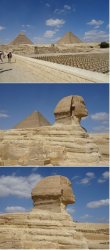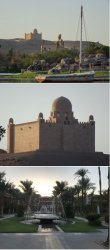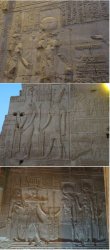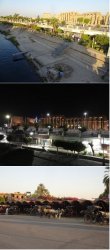A lot of interruptions at present, but getting back to this.
The afternoon was spent at the Egyptian Museum. It’s an old non-airconditioned building and space is tight. Superficially, it can feel a little jumbled inside but there is just so much stuff from a very long period that it can overwhelm. A half-day visit can do no more than skim the surface. The enthusiast could take more time and delve much more deeply.
The key exhibit is, of course, the Tutankhamun Galleries but no photos are permitted.
A massive new museum is under construction out near the pyramids.
I won’t attempt to describe stuff. A few pics will serve to give an idea of the museum for anyone who hasn’t been and is curious.
As you can see, like the whole time in Egypt, crowds were very light. Great for the visitor; not good for the economy. It was a not excessively hot day but I would not like to have been in there with large crowds.



Sunset from the hotel, about 8 km from the pyramids. The next day was driving to Alexandria, passing the pyramids and the new museum under construction.

A common sight in this part of Egypt is the pigeon towers. Pigeon is a commonly eaten meat. I’m guessing that people slip in at night while the pigeons are snoozing and grab a few for the pot.
Fort Quaitbey (1480AD) sits on the remains of the legendary Pharos lighthouse, one of the Seven Wonders of the Ancient World, which had been in operation for 17 centuries until being destroyed by an earthquake in the late 14th century. Ancient Alexandria of Cleopatra’s time lies under those boats bobbing on the ocean.

Al Montazah Palace and Gardens, built by the kings in the late 19th and early 20th centuries. Now used for state functions and not open to visitors.

The massive Bibliotheca Alexandrina is a spectacular and high-tech modern ode to the ancient Great Library of Alexandria, renowned as the ultimate archive of ancient knowledge. It is truly one of the great libraries of the world (
Home - Bibliotheca Alexandrina).

It was then back to Cairo to prepare for that night’s overnight train journey to Aswan.
Before that, a note on security. Egypt has an immense formal and long-established Tourist Police force that monitors all tourist group movements (for security, not repression). The Tourist Police are typically dressed in white uniforms (maybe to appear less intimidating than being dressed in combat gear?), although they are universally armed - typically with Heckler & Koch MP-5 9mm machine pistols or AK-47s.
Airport and train station forecourts are zones restricted to travellers only (brilliant!). Most hotels have a Tourist Police presence and tour guides log their group’s movements (eg. going out for a meal) with them. While ever-present, it wasn’t to me intimidating and it soon just becomes part of the background.
One slight variation occurred in Alexandria when the TP discovered that we had some Americans (two, IIRC) in our group. We then had a plainclothes TP officer join the bus and I believe that a plain car with other officers shadowed us back to Cairo. The plainclothes officer had a H&K MP-5 in a holster bulging slightly on his right hip under his jacket.
Trying to take pics surreptitiously in the train station forecourt…

Waiting for the train. IIRC, the station we used was about one stop from Cairo Central. The train was quite comfortable and certainly clean. A porter in each carriage attended to making up beds and bringing a basic whY-style dinner and breakfast. A perfectly reasonable experience. I slept well, as I always do on planes and trains.






































































